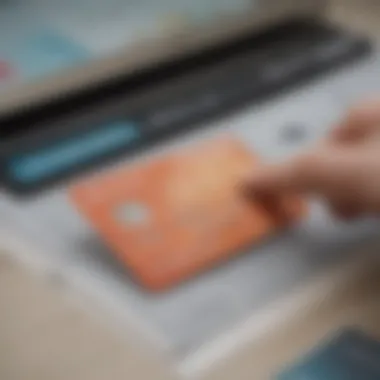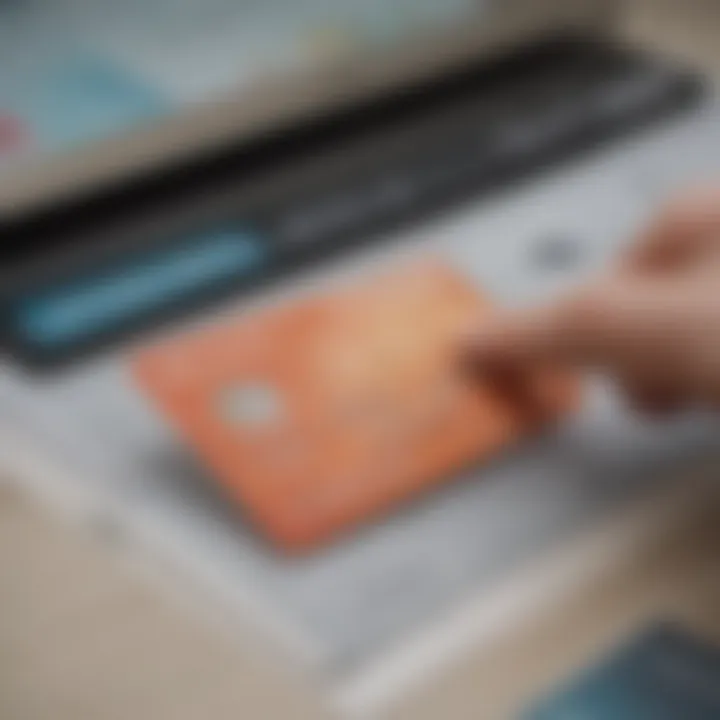Analyzing Buy Now, Pay Later Services: Afterpay & Klarna


Intro
The emergence of Buy Now, Pay Later (BNPL) services has fundamentally reshaped the landscape of consumer finance. Among the notable players in this arena are Afterpay and Klarna, which have gained considerable popularity for their flexible payment options that allow consumers to purchase immediately and defer payments over time. This model has not only appealed to the modern shopper but has also posed interesting challenges and opportunities for businesses and financial advisors alike.
As we dive into the intricacies of these platforms, one must understand how they operate, the financial implications they carry for users, and the broader impact on the retail environment. This exploration is pertinent, considering consumer habits have shifted toward seeking more accommodating payment solutions, particularly in an era of rising prices and economic uncertainty.
The goal of this article is to present a detailed analysis of Afterpay and Klarna, examining their unique functionalities, market positioning, user profiles, and the potential risks associated with their use. By unpacking these elements, we aim to enhance financial literacy and help both consumers and investors make informed decisions in today's evolving financial landscape.
Investment Dictionaries
Key Financial Terms Explained
Before diving deeper, understanding some key concepts related to BNPL services can be beneficial. These definitions can help frame our discussion as we dissect the workings of Afterpay and Klarna:
- Buy Now, Pay Later (BNPL): A payment option that allows consumers to purchase goods and pay for them over time, typically in interest-free installments.
- Merchant Services: Services provided to retailers that may include payment processing, financing options, and analytics to help improve sales.
- Consumer Debt: Debt incurred by individuals to finance their immediate needs or desires, which can include revolving credit and installment loans.
- Credit Score: A numerical representation of an individual's creditworthiness, often determining their eligibility for loans or credit.
Understanding Investment Jargon
The language of finance can sometimes feel bewildering. Here are a few phrases you might encounter while considering BNPL services:
- Cash Flow: The total amount of money being transferred in and out of a business.
- Default Rate: The percentage of loans that have not been repaid in accordance with the agreed terms.
- Point of Sale (POS) Financing: A type of financing that allows consumers to make purchases and split payments at the time of sale.
It's vital to familiarize oneself with these terms as they frequently come into play when dissecting the advantages and potential downsides of BNPL platforms.
Exploring Afterpay and Klarna
While Afterpay and Klarna share the core principle of allowing consumers to buy and pay later, their operational structures and customer engagement strategies differ significantly. In the following sections, we will thoroughly analyze their frameworks, differentiating factors, and consumer uptake to unveil the nuances that define their offerings.
Preface to Buy Now, Pay Later Services
In today’s fast-paced commerce landscape, the Buy Now, Pay Later (BNPL) model has marked a significant shift in how consumers engage with their purchases. This concept serves as a bridge between immediate gratification and financial prudence, allowing individuals to enjoy their acquisitions without the burden of upfront costs. The appeal of BNPL services, most notably illustrated by providers such as Afterpay and Klarna, lies in their ability to foster more accessible shopping experiences while simultaneously enhancing customer loyalty for retailers.
The importance of understanding BNPL services cannot be overstated. As these platforms proliferate, they not only influence consumer shopping behavior, but they also reshape retail strategies and financial planning. With a keen grasp of these services, investors, financial advisors, and educators can better navigate the evolving financial ecosystem.
Defining BNPL Services
Buy Now, Pay Later fundamentally denotes a straightforward payment option, where consumers can purchase items instantly and pay for them in installments over a predetermined period. Typically, this arrangement involves zero interest if payments are made on time, contrasting sharply with traditional credit cards that often carry hefty interest rates. The clear advantage here is the flexibility BNPL provides, allowing users to manage their cash flow better.
Many BNPL platforms also utilize a seamless integration with e-commerce sites, enhancing user experience. Shoppers can select BNPL at the checkout without needing to create a separate account, thus simplifying the purchasing process. This streamlining is critical, particularly in an age where convenience trumps almost every other purchasing criterion.
The Rise of BNPL Platforms
The surging popularity of BNPL services stems from various factors. Over recent years, consumer behavior has shifted towards wanting immediate access to goods while maintaining control over their finances. Recent data shows that a significant percentage of millennials and Gen Z consumers are gravitating towards BNPL products, reflecting a sturdy cultural shift - they aren't just looking to acquire items, but to do so in a manner that feels responsible and manageable.
Moreover, the rapid adaptation and evolution of digital payments have paved the way for these services. With smartphones and digital wallets becoming more common, consumers now expect a frictionless transaction experience. The rapid rise of e-commerce, accelerated by circumstances like the global pandemic, has further fueled interest and reliance on BNPL services.
Thus, platforms that offer BNPL solutions have positioned themselves well within both fintech and retail sectors. They provide not just payment options but also foster loyalty and repeat business, creating a cycle that benefits both consumers and retailers alike. As more businesses adopt BNPL offerings, they stand to gain from an expanding customer base eager to buy now and pay later.
Overview of Afterpay
Afterpay has carved a niche for itself in the bustling world of Buy Now, Pay Later (BNPL) services. Its significance in this article relates profoundly to understanding how it operates, what makes it distinctive, and its broader implications on consumer spending. By dissecting the functions and features of Afterpay, readers can grasp the potential advantages it offers, as well as some critical considerations they may encounter when using it.
Business Model and Revenue Streams
Afterpay adopts a unique revenue model that distinctly separates it from traditional lending systems. The core business model is built on providing an interest-free payment solution that allows consumers to make purchases and pay for them in installments. The process is straightforward: when a customer opts to use Afterpay at checkout, they typically split their payment into four equal chunks, due every two weeks.
This might seem like a piece of cake for users, but here’s where the financial mechanics get interesting. Afterpay generates its revenue primarily from retail partnerships and late fee charges. Retailers pay Afterpay a percentage of every transaction as a fee for facilitating these flexible payment options. This is a win-win scenario, as it allows stores to attract more customers who may otherwise hesitate to make significant purchases upfront. The late fees, while a secondary source of income, also serve as a means of encouraging responsible spending among users.
User Experience and Interface
Navigating the Afterpay platform is fairly user-friendly. Upon creating an account, users can link their debit or credit cards, giving them instant access to the BNPL feature. The interface is designed to be intuitive, ensuring that even the less tech-savvy individuals can complete their purchases with ease. Once an order is placed, Afterpay will send reminders for upcoming payments via notifications, helping customers keep track of their installment schedules.
The ease with which customers can use the service is one of its primary appeals. Afterpay’s app is streamlined and visually clean, allowing shoppers to view their upcoming payment dues and order history. It promotes a sense of control over financial commitments, which positively affects user satisfaction.
Retail Partnerships


The success of Afterpay is greatly amplified by its extensive network of retail partnerships. It collaborates with a range of retailers, from high-end fashion brands to everyday consumer goods. Notable partners include major names like Urban Outfitters, Sephora, and Forever 21. This broad acceptance across various sectors enables consumers to use Afterpay as a payment option in countless shopping scenarios.
Such partnerships generate reciprocal benefits; retailers attract new customers who prefer flexible payment options, while Afterpay expands its user base. Additionally, these collaborations often include marketing efforts that feature Afterpay prominently, leveraging its popularity to enhance visibility for participating brands. As more retailers embrace BNPL solutions, Afterpay stands to gain further traction, solidifying its position in the competitive landscape of payment services.
The combination of user-friendly design and strong retail partnerships contributes significantly to Afterpay’s rapid growth and adoption among consumers.
Overview of Klarna
Klarna stands out in the realm of Buy Now, Pay Later (BNPL) services, pushing the envelope on payment flexibility and customer experience. By dissecting Klarna's operations, we can uncover its importance in shaping consumer habits and enhancing retail strategies.
Business Model and Revenue Generation
Klarna's business model is akin to a fine-tuned machine, focused on creating frictionless transactions. Unlike traditional credit systems which rely heavily on interest charges, Klarna generates revenue through several avenues. The primary source comes from merchant fees, which are a percentage of the transaction value paid by retailers. This model creates a win-win scenario: merchants increase conversion rates due to Klarna's attractive payment options, while Klarna earns a share of the increased sales.
Another stream involves late fees charged to consumers who do not adhere to payment schedules. This aspect of their business model raises some eyebrows, as it has the potential to lead users into unwanted debt, reminiscent of credit card pitfalls. However, Klarna positions this as a convenience, emphasizing that their loans are manageable and encourage responsible spending. It’s a delicate balance they maintain, aimed at preserving customer relationships while ensuring profitability.
User Experience and App Features
Klarna's user experience is designed to feel seamless, almost as if the app goes beyond mere transactions into the realm of personal finance management. When users open the Klarna app, they're greeted with an intuitive layout that emphasizes ease of navigation. From browsing stores to tracking purchases, every aspect is integrated to minimize hassles.
Notably, the requirement of scant personal information allows customers to set up accounts quickly. The app offers instant credit decisions, enabling users to shop without the stress of drawn-out approvals. Furthermore, the feature that allows users to "Pay in 4" installments provides financial breathing room, facilitating purchases that may otherwise linger in the cart. This structuring encourages users to engage in more spontaneous shopping, contributing to higher retail sales.
Partnerships and Merchant Collaborations
Klarna's success can also be traced back to its strategic partnerships. They have cultivated relationships with thousands of retailers across various sectors, from big box stores to boutique shops. This strategy ensures that their service is widely accessible, enhancing consumer convenience. By joining forces with retailers, Klarna boosts visibility and drives traffic to partner platforms.
Moreover, integrating Klarna's service into existing checkout processes is a breeze, making it practically a plug-and-play solution for e-commerce businesses. As a result, merchants see higher conversion rates; shoppers are more likely to complete purchases when payment flexibility is offered. The symbiotic nature of these partnerships illustrates how both Klarna and its merchant collaborators can thrive together.
Klarna has established itself not just as a payment option but as a valuable ally in the retail landscape, enhancing both consumer purchasing power and retailer sales strategies.
Comparative Assessment of Afterpay and Klarna
A comprehensive evaluation of Buy Now, Pay Later (BNPL) services such as Afterpay and Klarna is crucial for understanding not only their individual offerings but also for revealing how they shape consumer behavior and the broader financial landscape. This section digs into the remarkable differences and similarities between the two platforms, focusing on fee structures, credit checks, user approval processes, and dispute resolution mechanisms.
Understanding these facets is essential for investors, financial advisors, and consumers alike, as they have direct implications on financial choices and strategies. These aspects not only aid the consumer during their shopping escapades but also determine the level of risk involved in utilizing BNPL services.
Fee Structures
When it comes to financial services, the devil is often in the details, particularly regarding fees. Afterpay operates on a straightforward model where users pay no interest; however, late fees can add up if payments aren’t met on time. This model assuages initial financial apprehension but can lead to a slippery slope for those with less-than-stellar budgeting skills.
On the other hand, Klarna presents a slightly different picture. Users may find themselves paying either a flat fee or interest depending on the type of payment plan they choose. Klarna's flexibility with payment timelines makes it appealing for many, but it can also confuse the user about potential costs over time.
Points to consider in fee structures include:
- Afterpay:
- Klarna:
- No interest if paid on time
- Late fees (up to $8, depending on the amount)
- Transparency in what you owe
- Select between interest-free options and plans with interest
- Possibility of hidden costs with certain plans that can accumulate over time
- Different fees based on the merchant
By closely examining these fee structures, you can better grasp which service aligns more closely with your financial habits.
Credit Checks and User Approval
The credit screening process is a major aspect to weigh when comparing Afterpay and Klarna. Afterpay takes a more lenient approach, often foregoing detailed credit checks entirely, which can make it accessible for younger consumers or those with subpar credit scores. This lack of a stringent assessment offers a quick route to spending but raises questions about long-term financial health for those who might not fully grasp their repayment capabilities.
Klarna, however, does conduct credit checks and may also have multiple user approval methods depending on the chosen service. This may seem stringent, but it aims to protect both the consumer and the platform from potential financial pitfalls. Important considerations here include:
- Afterpay:
- Klarna:
- No in-depth credit check
- Fast approval process
- Easier access to BNPL for a broad audience
- Uses credit checks, may affect credit score
- Different approval levels based on user history
- Capacity to be more risk-averse by evaluating customer credit-worthiness
Thus, users must weigh their immediate financial needs against the potential consequences of easy access to credit.


Dispute Resolution Mechanisms
In the realm of payment and financial services, especially with the rise of digital platforms, how disputes are handled can make or break the user experience. Afterpay tends to streamline dispute resolution through their straightforward process which can sometimes seem less formal. This may enhance user accessibility but could lead to frustrations should a genuine issue arise.
Klarna, in contrast, typically has more structured protocols in place, providing an assurance to the user that their concerns will be taken seriously. This more formalized system may invoke confidence, particularly for new users wary of the potential pitfalls associated with BNPL platforms. Factors to evaluate include:
- Afterpay:
- Klarna:
- Simple, often quick dispute resolution
- Customer reviews indicate mixed experiences
- Structured approach for problem resolution
- Greater assurance for those unfamiliar with BNPL services
"Dispute resolution plays a vital role in consumer trust and engagement with BNPL platforms. A good process can mean the difference between a satisfied customer and a lost one."
To sum it up, this comparative assessment sheds light on the intricate details that divide and connect Afterpay and Klarna. By diving into fee structures, user approval processes, and dispute resolution mechanisms, this section exemplifies how carefully assessing these factors can equip readers with the understanding necessary for making informed choices in the ever-evolving BNPL landscape.
Impact on Consumer Behavior
The emergence of Buy Now, Pay Later (BNPL) services has significantly transformed how consumers approach purchasing decisions. In this discussion, the focus will be on the underlying shifts in shopping habits and the psychological factors that drive the usage of services like Afterpay and Klarna. Consumer behavior—essentially the intricate dance of desires, motivations, and actions—influences the retail landscape at various levels.
Shifts in Shopping Patterns
The integration of BNPL options into the purchasing funnel has led to notable changes in shopping patterns. Many consumers, particularly younger generations, are increasingly favoring these flexible payment plans over traditional credit. It allows them a certain freedom, almost like walking on a tightrope without the fear of falling into debt directly. Shoppers are now more inclined to indulge in purchases they may have previously postponed due to financial constraints.
- Impulse Buying: With BNPL, there's a tendency to click that "buy now" button impulsively, often disregarding the total cost. The idea of paying in installments makes high-ticket items seem more approachable, almost like a mirage that one can afford with little thought to future implications.
- Increased Spend: Data suggests that consumers utilizing BNPL services tend to spend more per transaction compared to those who pay upfront. This phenomenon might stem from the perceived 'safety' net that BNPL offers. When people perceive that they can manage their finances more flexibly, they are willing to splurge just a little more, prompting retailers to capitalize on this consumer behavior shift.
- Greater Loyalty: Retailers offering BNPL options have seen an uptick in customer loyalty. Shoppers appreciate the ease and accessibility, leading to repeat purchases. This loyalty is a double-edged sword for both brands and consumers, as it engenders a cycle of spending that may extend beyond necessities.
As these shifts become ingrained in consumer habits, the ripple effects on overall retail sales and inventory management are compelling. It's crucial to monitor how threadbare the line grows between responsible spending and financial overreach among consumers.
Psychological Factors Influencing Usage
The psychological implications of BNPL are just as important as the tangible effects on spending patterns. Understanding these factors can shed light on why more individuals are opting for services like Afterpay and Klarna.
- Instant Gratification: In today’s fast-paced world, the desire for immediate satisfaction is a powerful driving force. The opportunity to possess an item now, while postponing the financial burden, aligns perfectly with this craving. BNPL services play into this want by providing a sense of urgency and immediacy without the immediate financial cost.
- Social Proof: Many consumers find comfort in knowing that they are not alone in their financial choices. The normalization of BNPL among peers creates an environment where using these services feels validated. Social media platforms amplify this behavior, with influencers often promoting such payment choices, further embedding it into collective consumer consciousness.
- Fear of Missing Out (FOMO): The pressure to take part in trending purchases can trigger FOMO among shoppers. For instance, if everyone is discussing a newly launched gadget, the wish to participate can quickly overshadow financial prudence. BNPL offers a way to engage in these trends while alleviating some of the discomfort of immediate payment.
In summary, the impact of BNPL services on consumer behavior is multifaceted. Changes in shopping habits paired with psychological drivers paint a complex picture of modern retail dynamics. Understanding these aspects can help stakeholders—be they investors, analysts, or financial advisors—navigate the evolving landscape of consumer preferences.
The correlation between the rise of BNPL and changing consumer behavior is evident, underscoring the need for a keen understanding of market trends.
Regulatory Environment
In a financial landscape increasingly dominated by flexible payment solutions, understanding the regulatory environment surrounding Buy Now, Pay Later (BNPL) services is crucial. This landscape shapes how platforms like Afterpay and Klarna operate while safeguarding both consumers and investors. As these services evolve, so too does the scrutiny they face from government bodies and regulatory authorities. This section will explore the regulations currently in place that affect BNPL services, as well as potential future changes and their implications.
Current Regulations Affecting BNPL Services
Currently, BNPL services exist in a somewhat gray regulatory area. Compared to traditional credit options, they are mainly unregulated, which leads to a lack of standardization across the industry. However, several key regulations are beginning to take shape:
- Consumer Protection Laws: Many countries have introduced consumer protection regulations that require BNPL companies to disclose the costs associated with their services openly. This aims to ensure consumers are well-informed about repayment terms, interest rates (if applicable), and any additional fees.
- Fair Lending Practices: In some jurisdictions, BNPL services must comply with fair lending laws. This prevents discrimination based on race, gender, or other personal factors when offering credit. As a result, companies are developing more thorough credit assessment processes to ensure compliance.
- Data Protection Regulations: With the increasing amount of consumer data being processed, BNPL providers must adhere to strict data protection regulations. For example, the General Data Protection Regulation (GDPR) in the European Union mandates how companies collect, use, and protect personal data.
"A well-regulated BNPL environment is essential for fostering trust and ensuring sustainable growth in this sector."
Despite these regulations, challenges persist as there are still no universal standards governing BNPL services. This inconsistency can confuse consumers and lead to unintended financial consequences.
Potential Changes and Their Implications
Looking ahead, several potential changes to the regulatory landscape of BNPL services may come into effect. Recognizing the impact of BNPL on consumer spending and debt levels, regulators might consider the following:
- Increased Scrutiny and Reporting Requirements: As regulatory bodies better understand the long-term implications of BNPL, there may be increased demands for transparency in reporting practices. Companies might need to regularly disclose data on loan performance and default rates.
- Limitations on Loan Amounts and Usage: To protect consumers from debt accumulation, regulators may impose limits on how much individuals can borrow via these platforms. Such limits could necessitate redesigned business models for companies to maintain profitability without overextending consumers.
- Consumer Education Initiatives: Potential regulatory changes could emphasize the importance of consumer education. Financial literacy programs might be mandated to ensure that users understand the terms and risks associated with BNPL services.
In summary, the regulatory environment is set to impact the future of BNPL services significantly. As afterpay and Klarna continue to evolve, how they adapt to these regulations will be critical in shaping their long-term viability and sustaining consumer trust. Furthermore, the ongoing dialogue between BNPL providers and regulatory authorities will likely determine the balance needed to foster innovation while maintaining a safe and secure financial ecosystem.
Financial Risks and Advantages
Understanding the financial risks and advantages associated with Buy Now, Pay Later (BNPL) services like Afterpay and Klarna stands as a crucial component in navigating today's consumer landscape. These services have rapidly changed the way people approach spending and payments. While the appeal of flexible payment options is undeniable, consumers and financial professionals alike must consider the implications that come along with them.
Potential Debt Accumulation


While BNPL platforms can be a tempting way to get what you want without immediate financial outlay, they can also invite hefty financial pitfalls. It’s easy to fall into the trap of thinking, "I’ll just pay it later." Before you know it, what started as a smart budgeting tactic can morph into a perilous cycle of debt. For instance, it is not uncommon for users to utilize multiple BNPL services simultaneously. This often leads to a snowball effect, where consumers pile on more payment obligations than they can handle.
- High Pressure to Overspend: Many users report feeling compelled to make purchases just because they can pay later. This deceptive affordability can stretch budgets thin and result in missed payments.
- Reportedly Rising Debt Levels: Surveys indicate rising levels of debt among BNPL users, as many underestimate their financial burden. This reality calls for prudent budgeting practices and awareness of one's financial limits.
It's important to emphasize that late fees can stack up quickly, leading to extra costs that users may not account for in their initial purchase plans. These additional expenses can detract from the supposed advantages of spreading out payments. When a customer misses a due date, they may find themselves racking up fees that can rival interest rates on credit cards.
"The thrill of instant gratification can overshadow the financial consequences, making awareness and education imperative for BNPL users."
Benefits of Flexible Payment Options
On the flip side, the flexible payment solutions offered by Afterpay and Klarna provide an avenue for empowered financial management, particularly beneficial for certain demographics facing cash flow challenges.
- Budget Control: One of the standout advantages is the ability to spread payments over time. When utilized wisely, these services can help maintain cash flow without derailing overall financial plans.
- Budget-Friendly Shopping: Customers often report feeling a sense of control, knowing exactly how much they need to pay and when. This can alleviate anxiety related to larger purchases.
- Access to a Broader Range of Products: Flexible payments can enable consumers to buy products they might defer otherwise due to price sensitivity. This opens new retail channels and enhances shopping variety.
The important takeaway is that while BNPL services offer a fresh way to engage financially, the success of these options relies heavily on disciplined spending habits. Both consumers and financial advisors must approach these services with cautious optimism, ensuring that they maximize the benefits while mitigating the risks.
Market Demographics
Understanding market demographics is crucial in grasping the overall impact and reach of Buy Now, Pay Later (BNPL) services like Afterpay and Klarna. The demographic composition of users helps both businesses and investors evaluate the potential for growth, risk assessment, and user engagement strategies. Specifically, demographics provide insights into trends like age, income levels, and shopping behaviors, which can influence how marketing strategies are structured.
The significance of studying demographics in this context cannot be overstated. Knowing who the typical users are enables companies to tailor their services and marketing efforts, ensuring they resonate with their audience. Additionally, it aids in identifying underserved communities who may benefit from BNPL offerings, fostering inclusivity in modern financial solutions.
Moreover, demographic data can guide regulatory approaches. By understanding which groups are more vulnerable to misusing credit, policymakers can develop better frameworks to protect consumers. Therefore, analyzing market demographics serves as a multi-faceted tool for both service providers and regulators, impacting strategic decisions across the board.
Typical Users of Afterpay
When we look at the typical user of Afterpay, we observe a clear trend. Afterpay attracts a predominantly younger clientele, with most users falling in the age bracket of 18 to 34. This demographic is tech-savvy and accustomed to online shopping, making them naturally inclined toward BNPL services, which offer immediate purchasing power without upfront payment. Many are students or early career professionals, who might possess inconsistent income streams but still desire access to consumer goods ranging from apparel to electronics.
Notably, this age group values experiences over possessions, often using Afterpay to finance travel or significant moments in their lives, such as festivals or events. They appreciate the flexibility of payment that lets them enjoy these experiences now and pay later, without accruing stubborn credit card debt. They feel comfortable sharing personal data for seamless transactions, which becomes increasingly essential in today’s digital focus.
Typical Users of Klarna
Klarna attracts a different, yet overlapping audience. While younger consumers are also part of Klarna's user base, the platform appeals to a slightly older demographic as well, usually between 25 to 45 years old. These users prioritize security, ease of use, and customer service when selecting payment options.
Many of them are established professionals who have a disposable income but prefer spreading out payments rather than making large purchases upfront. They seek value and insight into their spending habits, so Klarna's budgeting tools and app features attract them. They might also be more inclined towards higher-ticket items, such as home appliances or furniture, using Klarna's flexibility to manage cash flow effectively while still securing quality products.
Comparative User Profiles
When putting the user profiles of Afterpay and Klarna side by side, several distinctions surface. Afterpay users tend to prioritize immediacy and the pleasure of consumption, often utilizing the platform for smaller transactions. They value the ability to pay over time without interest, flourishing in the realm of quick purchases, commonly found in the fashion industry and entertainment.
Klarna users, in contrast, may see their profile as more financially prudent and deliberate. They not only look for BNPL options for immediate purchases but also tend to use the service as a budgeting tool. This is particularly evident in their penchant for larger purchases, pointing to a mindset that encompasses both desirability and planning.
The following bullet points summarize these comparative traits:
- Afterpay Users:
- Klarna Users:
- Age: Primarily 18 to 34
- Purchase Behavior: Frequent, smaller transactions
- Common Categories: Fashion, entertainment, and leisure activities
- Age: Generally 25 to 45
- Purchase Behavior: Less frequent but larger transactions
- Common Categories: Home goods, electronics, and lifestyle products
Recognizing these variations is key for businesses looking to succeed in the BNPL market. It can shape customer service approaches, marketing campaigns, and product partnerships, creating a more personalized shopping experience for different user segments.
Future Outlook of BNPL Services
The future of Buy Now, Pay Later (BNPL) services like Afterpay and Klarna is a topic of significant relevance within the modern financial landscape. As these platforms gain traction among consumers, understanding the evolution of BNPL is key for various stakeholders, from investors to financial advisors. Forecasting the trajectory of BNPL is not just an academic exercise; it provides insights into how retail and financial ecosystems may adapt in response to changing consumer behaviors and regulatory pressures.
Trends Influencing BNPL Growth
Several trends are steering the growth of BNPL services. These trends often intersect with broader shifts in consumer habits and technological advancements:
- Consumer Preferences Shift: There’s a notable shift towards convenience in payment methods. Today’s consumers are looking for flexible payment solutions that fit their lifestyles. This demand is increasingly shaping retail strategies, prompting merchants to integrate BNPL options in their checkout processes.
- Digital Shopping Surge: The boom in e-commerce, particularly accelerated by the pandemic, has propelled BNPL into the spotlight. As more consumers shop online, BNPL services are emerging as a practical solution to facilitate purchases without immediate financial burden.
- Millennial and Gen Z Engagement: Younger demographics, particularly Millennials and Gen Z, are at the forefront of adopting BNPL services. They gravitate towards options that provide financial flexibility while emphasizing the avoidance of traditional debt traps, attracting merchants eager to cater to this consumer base.
"The growth of BNPL services isn’t just a trend; it’s a response to a demand for financial flexibility that modern consumers are actively seeking."
Technological Innovations Shaping the Future
Technological advancements play a critical role in shaping the trajectory of BNPL services:
- Mobile Integration: The rise of mobile wallets and comprehensive apps is transforming how BNPL services function. A seamless integration into mobile platforms enhances user experience and encourages adoption.
- Data Analytics: BNPL platforms are increasingly leveraging big data to assess consumer behavior and make real-time credit decisions. This not only improves risk management but also creates personalized offerings based on spending habits.
- AI and Machine Learning: Advanced algorithms powered by artificial intelligence and machine learning can predict repayment probability and fraud detection, ensuring safer transactions for all parties involved.
- Blockchain Technology: Emerging interest in blockchain could help enhance transparency and security in BNPL transactions, appealing to consumers concerned about privacy and data protection.
In summary, the future of BNPL services is intertwined with technological innovation and evolving consumer preferences. Stakeholders must remain observant to navigate potential challenges and opportunities that these trends present.







